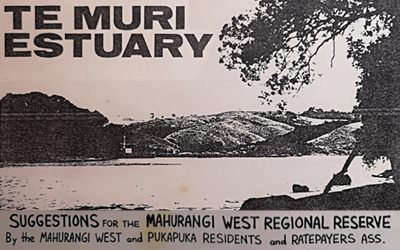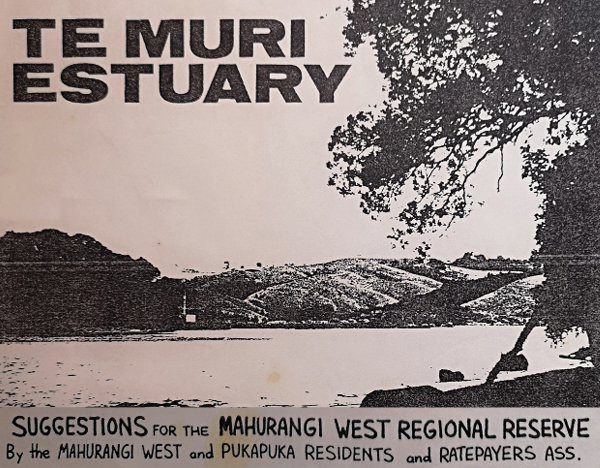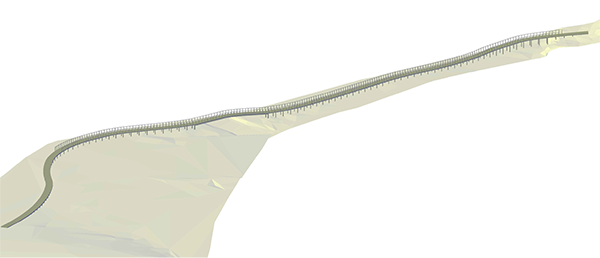Regional parks review round-1 feedback deadline extended


Thirty-Three-Year-Old Suggestions: The requirement for regional parks to address the climate emergency is now Auckland Council policy, but in 1987 the community’s argument—boosted by a healthy dose of deliberative democracy—that Te Muri’s sense of splendid isolation could be preserved, and public-health benefits delivered, if access was private-light-vehicle-free, won the day. The cover of the Mahurangi West community’s suggestion document, condensed here, reflects an unapologetic preoccupation with keeping Te Muri car-free. Or did until 2010. document Mahurangi West and Pukapuka Residents and Ratepayers Association
Round one of Auckland Council’s 10-year regional parks management plan review began 1 September.
It was to end next Monday afternoon, close of play, but has been extended to 26 October. The 12 October date continued to appear in the discussion paper linked, but has since been updated following a request by the Mahurangi Magazine.
The first round of the regional parks management plan review process is non-statutory, not that that makes it any less important. Having said that, in the similarly two-step 2015–2016 Te Muri management plan variation process, the community’s round-one feedback fell on deaf ears. The big change in Auckland Council’s default assumption that Te Muri would be accessed by road occurred in the second, formal part of the process. Just how much this had to do with the fact that 101 of the 140 round-one submissions explicitly supported Mahurangi Action’s concept of a coastal trail as the principal form of access, as did the vast majority of the nearly 400 received in total, and how much it owed to Auckland Transport advising that adequately upgrading road access, even to the park’s western boundary would be heinously expensive, can only be guessed.

Connecting Regional Parks Work-in-Progress: Although the Mahurangi Magazine suggests that the 1000-hectare greater-Mahurangi Regional Park should be considered one big-as beautiful park, the proposed Te Muri boardwalk and footbridge will in fact connect two named regional parks—Mahurangi and Te Muri. The rendering here will provide the skeleton of a depiction of the structure in a photograph-simulation, which will help commissioners and stakeholders, and, generally, those fond of Te Muri Estuary, to assess the landscape and visual impact of the proposed crossing. modelling Davis Coastal Consultants
In consultative processes such as regional parks management plan reviews, the community seldom has a clear sense of what it is up against, when it seeks to suggest a solution that challenges the status quo. While Aotearoa is indexed only a whisker below its top-14 peers in the participatory-democracy stakes, its weak deliberative-democracy index is largely responsible the country being placed 14th, below Ireland, Italy and Portugal. Deliberative democracy involves a back and forth, and, in an environment that is enquiring, respectful, and trusting, and can readily lead to a consensus that, long-term, avoids an enormous amount of community–council resources otherwise expended in opposition.
Then there is the sheer size of the exercise. The existing regional parks management plan runs a little over 500 pages. But given there were then 23 parks receiving their own section in the document, that is quite modest. If each park had its own plan, as was the case in 1994 when the Mahurangi Regional Park management plan boasted 109 pages, today’s 28 regional parks could have generated the greater part of 3000 management-plan pages. The downside of the omnibus approach, however, is that eyes on both sides of the community–council divide can all too readily glaze over. When, after uncountable volunteer hours by dozens of organisations and thousands of people, officer’s reports can reflect an almost siege mentality, all last vestiges of faith in participatory democracy are at risk of evaporation.
In 1987, when what was then known as Mahurangi West Regional Reserve was gaining its first management plan, deliberative democracy was being practiced, thanks to the Arnold Turner cmg-chaired citizens advisory group. The Mahurangi West community’s visionary Suggestions for the Mahurangi West Regional Reserve won the hearts and minds of the advisory group members, and the planned road bridge across Te Muri Estuary was dead in the water.
Where is the Love it, button!
The regrettable—not least for New Zealand’s aforementioned 14th democracy-index placing—loss of the deliberative-democracy round from subsequent management plan processes, makes providing feedback during this first round all the more imperative:
Regional Parks Management Plan Review Discussion Paper
Mahurangi Magazine feedback on Regional Parks Management Plan Review discussion paper
As lodged by 4.55 pm 26 October 2020
Thinking about all regional parks, what do you love about them and want to see protected or maintained?
That the wider Tāmaki Makaurau region has a rich network of large coastal parks where passive recreation, as opposed to organised recreation, is prioritised. The far-sighted fathers of the regional-park network—Frederick Jones and Judge Arnold Turner—acted to begin acquiring regional parkland for the future. That proactive regional parkland acquisition programme must not be regarded as job done—it must be ongoing, to meet the needs of inevitable regional population growth, particularly the needs of those choosing, or obliged, to live in denser settlements.
Regional parks will play a role in offsetting and reducing carbon emissions by 50% by 2030. How do you think regional parks should contribute to combating climate change?
The Regional Parks Management Plan Review Discussion Paper goal of planting 200 hectares of trees should be substantially increased, but with strong emphasis on science. Establishing indigenous species is famously expensive, yet trials conducted in the Mahurangi and Lake Taupō catchments demonstrate that forestry-stye open-ground nursery methods can slash that cost. Implementation of these learnings, and further trials, in the regional parks would impact a wide audience and contribute to greenhouse-gas-emission reduction and biodiversity gains, in the balance of the region, and Aotearoa.
Regarding the discussion-paper possibility of planting of exotics: where access and soil type is favourable, as a short-term measure, five-times-faster-than-indigenous-species radiata pine could usefully planted for high-end use, where the timber is put to long-lifespan uses. Because there would be vigorous pushback by those concerned to prioritise biodiversity gains, planting exotics short-term for harvest and long-term carbon sequestration gain would need to be robustly science-based and diligently collaborative. This is exactly the role that the regional parks should not shirk from, if its contribution to reducing carbon emissions is to be more than virtue signalling.
Regarding farming, much existing pasture should be retired. On that land which is retained in pasture, the emphasis should be on demonstrating humane, low-sediment-generating and low-greenhouse-gas-emission methods and technologies.
The Mahurangi Magazine strongly recommends that specialist science-based organisations such Tāne’s Tree Trust be asked to help design a policy framework to guide a 10-year programme of indigenous reforestation and exotic planted forest. Without reinventing the wheel, utilising such knowledge and expertise would better ensure optimum biodiversity and carbon sequestration outcomes. Tāne’s Tree Trust expertise in nurturing forestry in a mixed forestry and pasture landscape is ideally suited to the Auckland Regional Parks ethos, whereby pasture, and pockets of pasture, are retained and managed in sympathy with greenhouse-gas emission reduction goals.
Regarding the discussion paper question as to how visitors could reduce their vehicle emissions when travelling to parks, in itself, reinforces the prevailing private-light-vehicle-centric access model of Tāmaki Makaurau regional parks. The most powerful way the regional parks can contribute to slashing private-light-vehicle emissions to prioritise cycling access, public transport access (including ferry), and walking access.
https://www.tanestrees.org.nz/about-us/trustees/
Thinking about all regional parks, what changes could be made to better serve visitors?
Regarding the discussion-paper question about how the regional parks might manage higher visitor numbers and respond to visitor needs as the city continues to grow, the short answer is that regional parkland acquisition must continue at at least the same rate of the first five decades of acquisitions that began with Wenderholm Regional Park, in 1965. What might need to change is borrow-and-purchase approach deployed for Wenderholm and for much of the regional parkland acquisition. The Presidio and Sydney Harbour Federation Trust models, and, for that matter, an updated version of the Cornwall Park Trust, are just some options.
In addition to further acquisitions, however, there is a plethora of strategies whereby existing regional parks might manage higher visitor numbers, as they will need to, as evidenced already by the more central regional parks, famously Long Bay Regional Park. Many of the strategies will also address the climate emergency, most obviously the imperative to prioritise public transport access over private vehicle access, which aside from the climate, equity and public health benefits associated with public transport, exchanges car parking spaces for picnic sites.
Regarding the discussion-paper questions as to whether new directions should be developed for the regional parks and more offered, from leisure to accommodation. Again, the imperative to do this is the beyond-urgent need for climate-action mobilisation. When the unquestioned model was car-owning families visiting the parks complete with considerable picnic, or indeed camping, paraphernalia, there is now a clear need for visitors to be able to travel light, and purchase refreshments and accommodation within the regional parks.
The discussion-paper question as to whether a wider range of experiences or less-developed regional parks are preferred, the choices are not mutually exclusive. Regional parkland should continue to be prioritised for passive recreation, but moving away from private-light-vehicle access will require development. This, however, must be done in a manner that minimises the attendant landscape and visual impact.
Regarding the discussion-paper question as to whether free access to regional parks should continue, the answer is emphatically yes. The challenge of funding public open space in Aotearoa is not confined to the regional parks of Tāmaki Makaurau. The challenge must be addressed national level, including with a visitor tax adequate to cover the proportion of non-domestic public open space usage. Funding of public open space must be recognised as the public health investment it clearly is. It would be perverse in the extreme to discourage families with minimal to zero discretionary spending capacity from visiting regional parks.
Regarding the discussion-paper question as to how regional parks might generate income to help pay their way, lessons from the aforementioned Presidio and Sydney Harbour Federation Trust models, and elsewhere, should be applied. Scott Homestead, for example, could be operated by a charitable trust, providing the sort of genteel hospitality of the volunteer-operated Everglades House & Gardens tea rooms, Leura, New South Wales. A limited marquee wedding season available to wedding parties prepared to access via bus or ferry would provide the bulk of income, in the latter respect, à la the Mahurangi West Hall.
https://www.ncbi.nlm.nih.gov/pmc/articles/PMC5922198/
What concerns do you have about their use?
When the Auckland Regional Parks were conceived by Frederick Jones in the 1950s, Auckland was determinedly embarking on a motorways-centric transport strategy. Accordingly, the regional parks were private-light-vehicle-centric. This has led to the regional parks becoming part of the global greenhouse gas emissions problem, in that park use generates private-light-vehicle journeys, and prioritises private-light-vehicle access, the parking implication of which less space for passive recreation, particularly on the level terrain near beaches that should be prioritised for human use, such as picnicking and play. The suggestion of providing electric vehicle charging stations is virtue-signalling of the most egregious kind, failing to recognise the urgent need to signal that the regional parks are being managed for people, and for public health, and not for cars.
What would you like to be able to do on regional parks?
To enjoy any semblance of wellbeing, acutely aware that climate action procrastination might already have destroyed the opportunity to salvage a survivable climate, to be able to do things in the parks that play a meaningful role in offsetting and reducing carbon emissions. This begins with the journey to reach a regional park, and ends with the journey home afterwards. While in the park, to be able to walk or cycle, and occasionally, to ride on horseback, from one end of a park to the end of an adjoining one, and to be able to depart from there via public transport. Included in the vision for the Mahurangi Coastal Trail, for example, is for young people to be able to cycle from the Snells–Algies settlements on the Mahurangi Peninsula, much of it through regional parkland, to visit the Waiwera mineral pools for a high-adrenalin fix. To camp in numbers on Auckland Anniversary weekend, within easy walking distance of the Mahurangi Regatta.
Do you have any other comments or suggestions about regional parks or for the regional parks management plan?
The approach taken that is formalised by the memorandum of understanding between Auckland Council and the Mahurangi Coastal Trail Trust has resulted in unprecedented progress towards realising the Mahurangi Coastal Trail—a concept first proposed in writing in 1987, to the then citizens advisory group of the Auckland Regional Authority. The focus of the memorandum of understanding is progressing the non-vehicular access to Te Muri Regional Park via a boardwalk and footbridge to Mahurangi West, as identified as the access priority in the Te Muri Regional Park variation to the 2010 regional parks management plan, adopted in 2017. Once the proposed Te Muri crossing is consented, it is envisaged that the memorandum of understanding will be reviewed and expanded to address the next stage of the Mahurangi Coastal Trail’s progress towards connecting the greater, 1000-hectare Mahurangi regional park. The success of the memorandum-of-understanding approach suggests a model for the greater Mahurangi coastal trail, from the Hibiscus Coast to Mangawhai, connecting seven regional parks.
This feedback is from the Mahurangi Magazine, which functions as an editorially independent mouthpiece for Mahurangi Action Incorporated, established 1974 as Friends of the Mahurangi. It is also on behalf of the Mahurangi Magazine readership, in that the feedback was developed transparently online, with readers invited to contribute.
https://www.mahurangi.org.nz/2020/03/20/sweet-te-muri-crossing-consensus/
https://www.mahurangi.org.nz/2020/10/05/regional-parks-review-feedback-deadline-extended/
Regional Parks Management Plan Review Discussion Paper

I am most impressed with the amount of careful thought that has gone into the consideration of the discussion paper of the review of the Auckland Regional Parks Management Plan.
It gives me hope. I was around in the days when the Regional Parks were in an early stage of development. I did not get involved because of family and commercial pressure. I feel ashamed of that now! But chiefly I am filled with a sense of the purpose and the achievements of those who have stuck with the argy-bargy required fora continuous involvement with the issues. Good on you guys.
We are beginning to see the future. You saw it long ago, and I can only say Thank God for that!